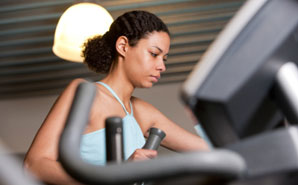
Image: Hemera | Thinkstock
Elliptical trainer. Cross-trainer. ARC Trainer. They come in all sizes, colors and shapes, with many different features, adjustments and additions. I thought I’d talk a little bit about the basics on how to use this behemoth of a machine. It can be, and is quite intimidating at first blush, but is one of the most versatile and effective pieces of equipment out there in the fitness world for the beginner and advanced. It bothers me when someone takes an interest in theses machines and then shy’s away from them because they are either afraid they may get hurt, think they don’t have the coordination, or simply don’t understand how it works.
Who is this machine meant for?
Anyone and everyone! Bad (weak) knees /ankles, hips? Do you have a weak ‘core’? How about a weak (or bad) back? Do you want to increase your cardiovascular fitness without stressing your joints (knees, hips, ankles)? Interested in strengthening your upper or lower body? This is the machine for you. The elliptical motion takes almost all the stress off of your joints while simultaneously challenging your cardiovascular endurance. The elliptical motion also forces you to activate your core. You have to maintain your balance throughout the movement and exercise.
Parts of the machine of interest
Foot pedals / rests
This is where you place your feet. Be sure to keep them balanced and secure. The more you increase the incline or resistance of the machine the more your feet will move, so be careful.
Moving arm bars / handles
These are great for helping you maintain balance when you first try this machine. They also are a great way to ‘work’ your upper body simultaneously when you’re ‘running’ on the machine. I would highly suggest you spend more time not holding on to these – it forces you to use your core more. Balance is essential
Resting arm bars / handles
Stay as far away from these as possible. They are only there for resting periods and to help you regain your balance when you lose it. Don’t lean on these things. I see too many people leaning on these bars, leaning forward, and just pedaling away. If this is all your are going to do, then get off the machine and walk on the treadmill, otherwise let go of those handles and strengthen your core!
Wheel / cylinder
This is usually the moving part of the machine where the foot pedal / moving arm bar are connected so to move in the elliptical motion. Some machines have it in the front, some are in the back. If you can, be sure to pay attention to which way the cylinder is rotating. Always attempt to keep it moving in a forward motion, not backward.
Front LED panel areas of interest
Resistance
This is the difficulty level of rotating the ‘wheel’. The higher the resistance the harder it is to push your feed forward. It’s likened to pedaling a bicycle uphill.
Incline or angle
This is the degree of incline of the actual stepping motion. The higher the incline the higher you have to step ‘up’. It’s likened to taking one step versus taking two or three steps at once.
Distance
It’s a mathematical computation of how far you are traveling based on how many revolutions have been made on the ‘wheel’. It’s a guestamation, not an accurate measurement. I would suggest only using it as a way to monitor your progression over time, not a single use.
This is by far one of the most important statistics given to you. It is also a calculated expression. While you can measure your ‘work’ by how fast you pedal, or how tough the resistance is, or how high the incline is, this measurement gives you all those factors rolled into one. This number is only relative, but it can tell you whether or not you are working harder. The higher this number, the harder, the tougher and the more exhausted you will get (and fast!)
There are a myriad of other features that can or cannot be offered with a particular machine. Some offer the ability to measure your heart rate, some have TV’s, built in fans, etc. This list is endless. I only touched on the basics, which I think are the most important. Get these basic functions down and you are one step ahead of someone else.
Listen, it’s not an easy machine to master. It takes time and patience. The first time you get on this thing, you will feel like a goof-ball. In fact you may very well lose your balance and footing (I did!). Don’t get discouraged. With anything new, practice makes perfect. Go slow, go steady, and be consistent, but whatever you do don’t quit!
I have ‘bad’ knees and get ‘shin splints’ in a blink of an eye due to my own medical history. This machine solved all those woes. I can run, jog, and sprint at my own leisure and not feel these ill effects. I get a great ‘run’ in, my legs get put through ringer and in the end my heart, my lungs and my circulation have benefited from my time.
I’d love to hear any additional tips you may have regarding this machine. Yah or nay?

















